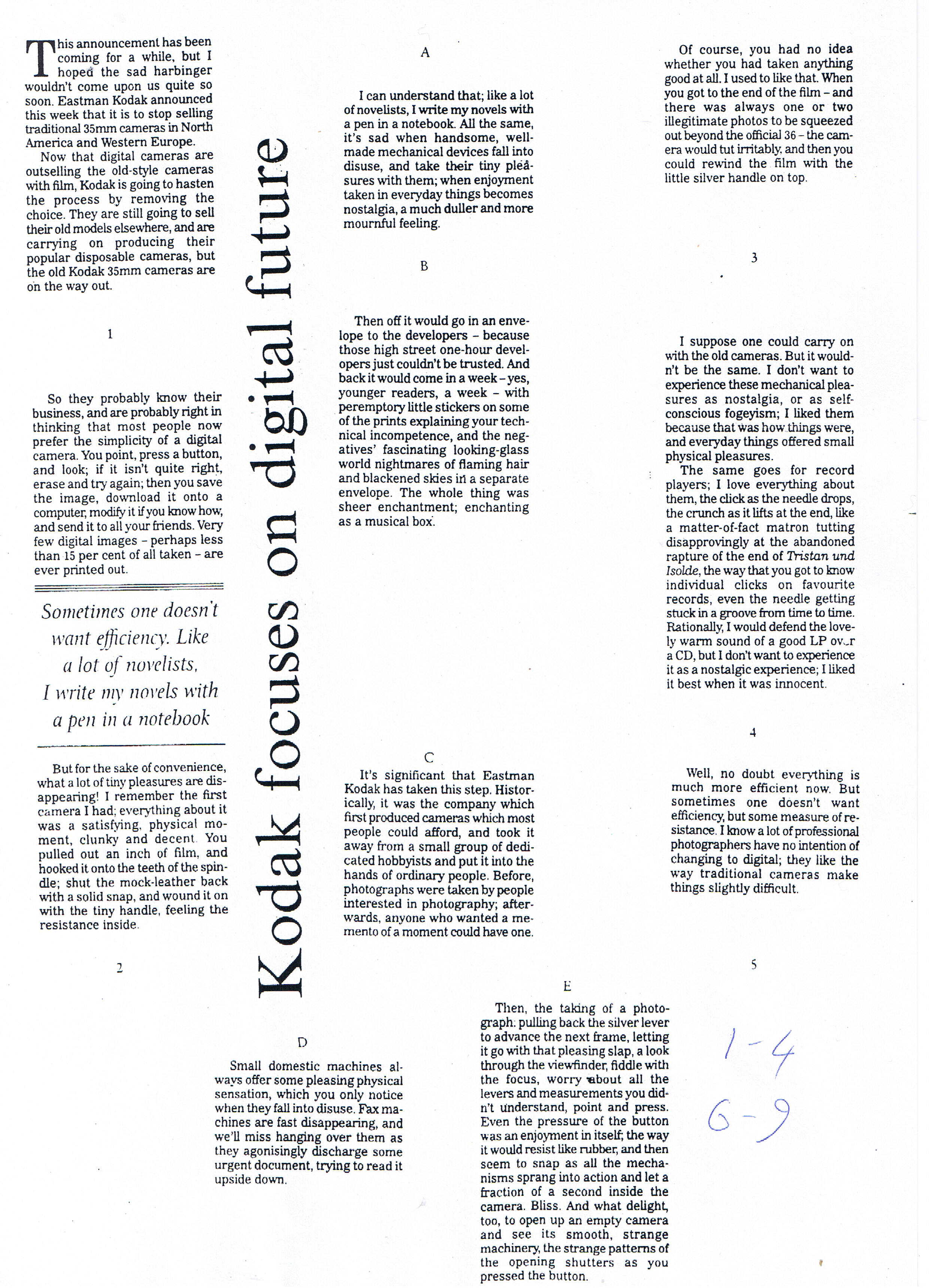1 (364)

This announcemenl has been coming for a while, but I hoped the sad harbinger wouldn’t come upon us quite so soon. Eastman Kodak announced this week that it is to stop selling traditional 35mm cameras in North America and Western Europę.
Now that digital cameras are outselling the old-style cameras with film, Kodak is going to hasten the process by removing the choice. They are still going to sell their old models elsewhere, and are carrying on producing their popular disposable cameras, but the old Kodak 35mm cameras are on the way out.

I can understand that; like a lot of novelists, I write my novels with a pen in a notebook. Ali the same, it’s sad when handsome, well-made mechanical devices fali into disuse, and take their tiny pled-sures with them; when enjoyment taken in everyday things becomes nostalgia, a much duller and morę mournful feeling.
Of course, you had no idea whether you had taken anything good at all. I used to like that. When you got to the end of the film - and there was always one or two illegitimate photos to be sąueezed out beyond the official 36 - the camera would tut irritably. and then you could rewind the film with the little silver handle on top.
B
3
1

So they probably know their business, and are probably right in thinking that most people now prefer the simplicity of a digital camera. You point, press a button, and look; if it isn’t quite right, erase and try again; then you save the image, download it onto a Computer, modify it if you know how, and send it to all your friends. Very few digital images - perhaps less than 15 per cent of all taken - are ever printed out.

Then off it would go in an enve-lope to the developers - because those high Street one-hour devel-opers just couldn’t be trusted. And back it would come in a week - yes, younger readers, a week - with peremptory little stickers on some of the prints explaining your tech-nical incompetence, and the neg-atives’ fascinating looking-glass world nightmares of flaming hair and blackened skies in a separate envelope. The whole thing was sheer enchantment; enchanting as a musical bok.
Sometimes one doesrit want efficiency. Like a lot of novelists,
I write my norels with a pen in a notebook
But for the sake of convenience, what a lot of tiny pleasures are dis-appearing! I remember the first camera I had; everything about it was a satisfying, physical moment, clunky and decent You pulled out an inch of film, and hooked it onto the teeth of the spin-dle; shut the mock-leather back with a solid snap, and wound it on with the tiny handle, feeling the resistance inside
I suppose one could carry on with the old cameras. But it would-n’t be the same. I don’t want to experience these mechanical pleasures as nostalgia, or as self-conscious fogeyism; I liked them because that was how things were, and everyday things offered smali physical pleasures.
The same goes for record players; I love everything about them, the click as the needle drops, the crunch as it lifts at the end, like a matter-of-fact matron tutting disapprovingly at the abandoned rapture of the end of Tristan und Isolde, the way that you got to know individual clicks on favourite records, even the needle getting stuck in a groove from time to time. Rationally, I would defend the love-ly warm sound of a good LP ov.,r a CD, but I don’t want to experience it as a nostalgie experience; I liked it best when it was innocent.
4
c
It’s significant that Eastman Kodak has taken this step. Histor-ically, it was the company which first produced cameras which most people could afford, and took it away from a smali group of dedi-cated hobbyists and put it into the hands of ordinary people. Before, photographs were taken by people interested in photography; after-wards, anyone who wanted a memento of a moment could have one.
Weil, no doubt everything is much morę efficient now. But sometimes one doesn’t want efficiency, but some measure of resistance. I know a lot of professional photographers have no intention of changing to digital; they like the way traditional cameras make things slightly difficult.
i

E
D
Smali domestic machines always offer some pleasing physical sensation, which you only notice when they fali into disuse. Fhx machines are fast disappearing, and we’ll miss hanging over them as they agonisingly discharge some urgent document, trying to read it upside down.
Then, the taking of a photo-graph. pulling back the silver lever to advance the next frame, letting it go with that pleasing slap, a look through the viewfinder, fiddle with the foCUS, WOrry ■about all the levers and measurements you did-n’t understand, point and press. Even the pressure of the button was an enjoyment in itself; the way it would resist like rubber, and then scem to snap as all the mecha-nisms sprang into action and let a fraction of a second inside the camera. Bliss. And what delight, too, to open up an empty camera and see its smooth, strange machinery, the strange pattems of the opening shutters as you pressed the button.

Wyszukiwarka
Podobne podstrony:
Copyright statement This presentation has been prepared for a university lecture. thus for a non-pro
2 (1040) GjoLD CoLLECJlON 3853 THUNDER RIDGE This design has been created especially for you. If you
Best PracticeGuide Guide for teachers This project has been funded with suppoit from the European Co
277 SHORT NOTES Even though interest in funeral sermons has been growing for years, Polish research
37129 secretsmanwasnotmeantoknow1 Meant Holder of this card may play it aftor any other special
pll do Veronica NRG KITS PLL-PRO 2Although this model has been replaced with the superieor PLL-PRO 3
iThe manner of easing the lockdown has been gradual for all EU5 nations to minimise the risk of seco
The CPTWD system has been employed near Parma (Italy) in the geotechnical surveys for the project of
c Page Blossom Necklace The project for ONE shuttle and BALL. The original has been designed for Pa
Important Windows 10 bhortcuts to Remember Windows 10 has been around for morę than a year now and s
pll do Veronica NRG KITS PLL-PRO 2Although this model has been replaced with the superieor PLL-PRO 3
Certificate of R This certificate has been awarded toKalcit s.r.o. Lom Brno - Liśe
Certificate of Registration This certificate has been awarded toKalcit s.r.o. Triskalova 902/1 Oa, L
SAFETY PRECAUTIONSFederal Communications Commission (FCC) Statement This Equipment has been tested 3
1.3 Thesis topie and scope of the research Change management has been studied for a long time. Succe
this device has been previously characterized experimentally by optical holographic techniques. Thes
więcej podobnych podstron